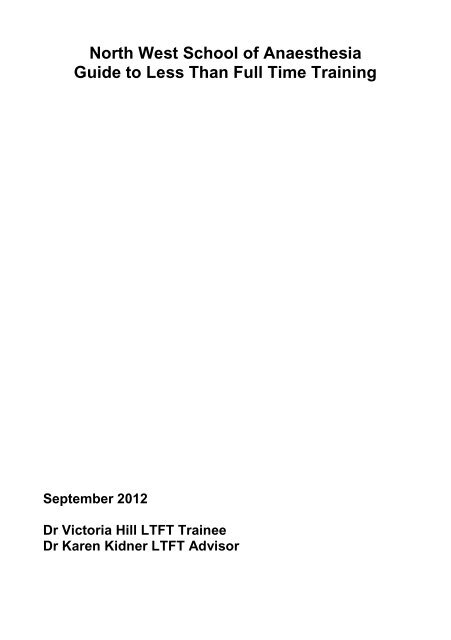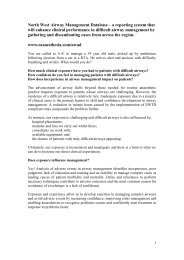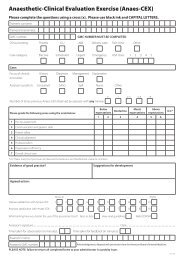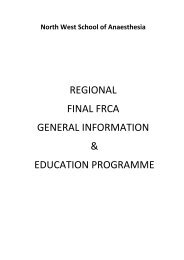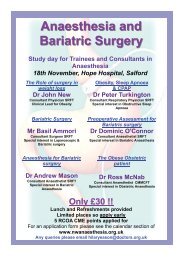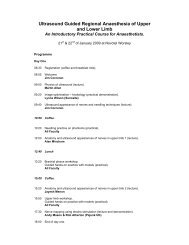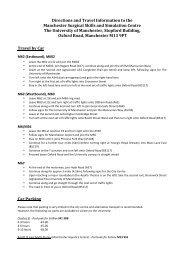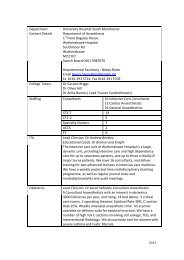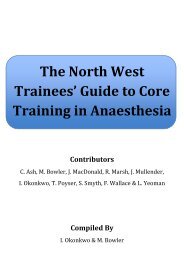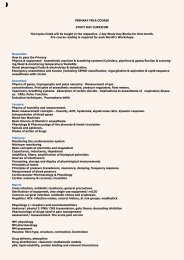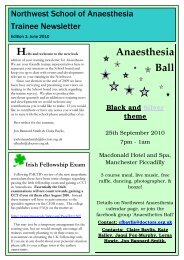Guide to Less Than Full Time Training - North West School of ...
Guide to Less Than Full Time Training - North West School of ...
Guide to Less Than Full Time Training - North West School of ...
- No tags were found...
Create successful ePaper yourself
Turn your PDF publications into a flip-book with our unique Google optimized e-Paper software.
ContentsBeginning LTFT <strong>Training</strong>What is LTFT <strong>Training</strong>? 5Who is eligible <strong>to</strong> train LTFT? 5If I am eligible, is the deanery obliged <strong>to</strong> provide LTFT training? 5If I am found not <strong>to</strong> be eligible for LTFT training, can I appeal? 6How <strong>to</strong> apply for LTFT training 6Returning <strong>to</strong> work (RTW) 6Is the RTW process different for those returning from sickness absence? 7Is the RTW process different for more junior trainee anaesthetists? 7When should I restart my on-calls? 7Who needs <strong>to</strong> take part in a RTW Programme? 7Additional resources for RTW 7Information for the LTFT TraineePlacement arrangement 8Pay 8Adding up your hours 9Work pattern 10Do I get the same post-on-call days <strong>of</strong>f as my colleagues? 10Do I have <strong>to</strong> work Friday day on-calls if I don’t usually work Friday? 11Annual Leave 11Study Leave 12Bank Holidays 12On-call and additional employment 13ARCP 13CCT Date calculation 132
Introduction<strong>Less</strong>-than-full-time (LTFT) training is common in anaesthesia with 8.5% <strong>of</strong> trainees acrossthe country choosing <strong>to</strong> work this way. We hope this guide will provide answers <strong>to</strong> somecommon queries. For further information please contact Dr Karen Kidner, LTFT trainingadvisor: karen.kidner@lthtr.nhs.uk4
TZIEROPOULOS 2Ten Years Behind NME Lines, and Beyondsurface <strong>of</strong> WTO. At last, the s<strong>to</strong>ry <strong>of</strong> China's accession is a sharp reminder that what countriessay and what they actually do is <strong>of</strong>ten very different.More significantly, the example <strong>of</strong> China's accession provides a formidable insight <strong>of</strong>the major shifts that the global economy has witnessed in the last 25 years. With theincreasing irrelevance <strong>of</strong> tariffs and the rise <strong>of</strong> global supply-chains fueled by emergingeconomies, the industrialized nations have been struggling <strong>to</strong> maintain their dominant positionin sec<strong>to</strong>rs where they no longer have a comparative advantage. A minor economy in 1980,China has since grown at a sustained rate <strong>to</strong> become the world's second largest trader in 2009.Trade relations between China and the world reflect these changing economic dynamics, andalso exemplify changing political discourses from both sides. At the core, the issue underlyingthese changes is how <strong>to</strong> deal with the Chinese 'hybrid' economy and its gargantuanproportions. One <strong>of</strong> the goals <strong>of</strong> this paper is <strong>to</strong> show that powerful ac<strong>to</strong>rs have attempted <strong>to</strong>use the multilateral trading system <strong>to</strong> curb the Chinese expansion, and <strong>to</strong> discuss theshortcomings <strong>of</strong> this approach. Finally, this case study depicts the growing assertiveness <strong>of</strong>China in an increasingly multipolar world and the implications it may entail, shouldprotectionist approaches be pursued from now on.With a view <strong>to</strong> examine these questions, this paper will first address the process <strong>of</strong>accession in a his<strong>to</strong>rical perspective. The first chapter describes the Chinese political contextand trade relations, in particular with the United States, during the negotiations. The chapterconcludes by an outline <strong>of</strong> China's Pro<strong>to</strong>col <strong>of</strong> Accession. The second chapter addresses traderemedies (i.e. antidumping and anti-subsidization) in 'China's WTO'. By reviewing theeconomics, politics and regulations <strong>of</strong> antidumping and countervailing duties, this papershows that they can be strongly presumed <strong>to</strong> be used <strong>to</strong>wards protectionist ends. This chapterdiscusses in detail the specific provisions <strong>of</strong> the Pro<strong>to</strong>col <strong>of</strong> Accession which may be usedagainst Chinese imports, with a particular emphasis on China's 'non-market economy' ('NME')status, and finds that these have a strong discrimina<strong>to</strong>ry bias. Finally, the second chapter takess<strong>to</strong>ck <strong>of</strong> the different strategies adopted by China in response <strong>to</strong> its differential treatment intrade remedies investigations.* * *
Placement ArrangementSection 2: Information for the LTFT TraineeThere is a process <strong>of</strong> placement arrangement that must be complete 3 months beforeyou change trusts, every time you change trusts. This is because the host trust willneed <strong>to</strong> agree <strong>to</strong> meet the additional costs <strong>of</strong> having a LTFT trainee. The steps are asfollows:1. Request an e-approval form from the LTFT administra<strong>to</strong>r at the deanery:LTFT@nwpgmd.nhs.uk. Fill in part one and forward <strong>to</strong> your TPD. For ST3+ thiswill be Dr Thorn<strong>to</strong>n: sjthorn<strong>to</strong>n@mac.com.2. The TPD will forward your e-approval form <strong>to</strong> your Educational Supervisor at thepotential placement.3. The Educational Supervisor will first seek approval from the Clinical Direc<strong>to</strong>r andthen the trust’s staffing and finance departments.4. The e-approval form with all above signatures must then be sent <strong>to</strong> the LTFTadministra<strong>to</strong>r at the deanery.Initiation <strong>of</strong> this process is the responsibility <strong>of</strong> the LTFT trainee. It is recommendedthat you ask all recipients <strong>of</strong> the e approval form <strong>to</strong> copy you in as they forward the form on<strong>to</strong> the person in the next step.PayLTFT trainees’ pay is calculated in a different way <strong>to</strong> their full-time equivalents. It consists<strong>of</strong> basic salary (determined by <strong>to</strong>tal hours worked) plus a supplement (reflecting intensity<strong>of</strong> on-call duties).The actual number <strong>of</strong> hours you work falls in<strong>to</strong> a bracket which determines your basic pay:Title <strong>of</strong> Band Hours worked per week salary (as a proportion <strong>of</strong>full-time basic salary)F5 20- 23.9 0.5F6 24- 27.9 0.6F7 28-31.9 0.7F8 32-35.9 0.8F9 36-39.9 0.9For doc<strong>to</strong>rs who work full-shift rota patterns the supplement added is as follows:8
Band Conditions Supplement payable as apercentage <strong>of</strong> thecalculated basicFAWorking 1 weekend in 6.5 or morefrequently OR more than 1/3 <strong>of</strong> your dutyhours fall outside 7am <strong>to</strong> 7pm Mon- Fri50%FB Does not meet requirements for FA 40%FC On call, non-resident. 20%Once your basic salary band and supplement band are known your <strong>to</strong>tal salary iscalculated as follows:Total salary = salary* + (salary x 0.5 if FA, 0.4 if FB etc.)*salary = F5 <strong>to</strong> F9 as detailed aboveFor example, Vicky works 60%. She examines her rota and finds she is working 28 hoursper week (Salary band F7). One third <strong>of</strong> her hours <strong>of</strong> duty fall outside the period 7am <strong>to</strong>7pm Mon-Fri (Supplement band FA). Her overall banding is F7A and she will receive herbasic salary plus 50%.Hours are subject <strong>to</strong> moni<strong>to</strong>ring and trainees will be re-banded as with their full-timecolleagues should their actual hours worked fall in<strong>to</strong> a different band than suggested bytheir rota.The above is a summary <strong>of</strong> the pay structure as it is relevant <strong>to</strong> most anaesthetic trainees.For further detail or information please visit:http://www.nhsemployers.org/SiteCollectionDocuments/doc<strong>to</strong>rstraining_equitable_pay_cd_080405.pdfAdding up your hoursAlthough some trusts issue LTFT trainees with a template work pattern, it is unlikely <strong>to</strong>look much like the on-call rota when you get it. As a LTFT trainee it is important <strong>to</strong> assessyour rota <strong>to</strong> ensure you are working the correct number <strong>of</strong> hours and that the correctproportion <strong>of</strong> this time is spent ‘on call.’ There are a few trusts in which your college tu<strong>to</strong>ror rota master will assess your hours with you, but the majority <strong>of</strong> the time you must do thisfor yourself.In order <strong>to</strong> work out how many hours you should be working, you need <strong>to</strong> know how manyhours your full time colleagues on the same rota are working. If your colleagues areworking the maximum 48 hours per week, and you are 60%, you should be working 0.6 x48= 28.8 hours per week.As your training should be equivalent <strong>to</strong> that <strong>of</strong> a full time trainee, you should be on-call thesame proportion <strong>of</strong> your <strong>to</strong>tal hours as the full time trainees are unless you are in a RHFTslot and have opted <strong>to</strong> do more on-call than you are required. The following example <strong>of</strong> atrainee working 60% is taken from the ‘<strong>Less</strong> than <strong>Full</strong> <strong>Time</strong> <strong>Training</strong> in Anaesthesia: An A<strong>to</strong> Z <strong>Guide</strong>’ which can be found at: http://www.rcoa.ac.uk/node/1540.9
“To ensure that you experience equivalence training, the proportion <strong>of</strong> hours spent doingelective and emergency work should also be pro rata. Thus, you should be doing 0.6 <strong>of</strong> theout <strong>of</strong> hours’ work that the full time trainees do. To ensure this you need <strong>to</strong> know howmany people are on your share <strong>of</strong> the rota, for example if there are 7 full time trainees andyou that equates <strong>to</strong> 7.6 people.The following example uses 8 weeks <strong>of</strong> rota with 7.6 trainees:Work out the number <strong>of</strong> weekends (Fri/Sat/Sun); In 8 weeks there will be 8 days weekendsand 8 nights weekends <strong>to</strong> cover i.e. in <strong>to</strong>tal there are 16 weekends <strong>to</strong> cover.LTFT weekends <strong>to</strong> do in 8 weeks = (16/7.6) x 0.6= 1.23So in 8 weeks you will do at least one weekend, you may do 2 but then in the next 8 weekperiod that should even out.Then work out how many weekday shifts; Each day Mon <strong>to</strong> Thurs will require a long dayand a night shift meaning 8 shifts per week should be covered. So in 8 weeks there are 64shifts <strong>to</strong> cover.LTFT <strong>to</strong>tal weekday out <strong>of</strong> hours work = (64/7.6) x 0.6=5.05So in 8 weeks you should do 5 <strong>to</strong> 6 shifts, which should be split between days and nights.Ideally your <strong>to</strong>tal shifts (weekends and weekdays) should be evenly spread between daysand nights.It will not work out exactly for each rota period unless you are on a fixed rolling rota bu<strong>to</strong>ver 6 months it should even out. If you find you are doing virtually the same numbers <strong>of</strong>on call shifts as the FT trainees then something is going wrong – even if your hours onpaper are still 28.8 (0.6 x 48) you are losing training daytime lists. It is wise <strong>to</strong> keep a diary<strong>of</strong> your weekly working hours and <strong>to</strong> discuss this with the rota maker as soon as possible<strong>to</strong> ensure you don’t lose training opportunities.”Work PatternThe trusts are not obliged <strong>to</strong> allow you <strong>to</strong> choose your days <strong>of</strong> work. Most LTFT traineeshave a structured support system in place e.g formal childcare sessions, which cannot beeasily changed whenever they move placements, and most trusts appreciate this and dotheir best <strong>to</strong> accommodate your needs. However if there are several LTFT trainees in onedepartment it may not be possible for all <strong>of</strong> you <strong>to</strong> work the same days as it may leave thedepartment short on other days. In this situation it will be necessary for you as a group <strong>to</strong>come up with a solution <strong>to</strong> this that may involve working different days <strong>to</strong> those originallyplanned.You may find that you need <strong>to</strong> work outside <strong>of</strong> your regular days from time <strong>to</strong> time e.g <strong>to</strong>attend a particular list which <strong>of</strong>fers educational opportunities unavailable on a day youusually work.The <strong>of</strong>ficial deanery position states that: “Trainees should not dictate the terms andconditions <strong>of</strong> their LTFT training placements <strong>to</strong> trusts. The process is one <strong>of</strong> negotiationbetween all relevant parties. The requirements <strong>of</strong> the relevant curriculum have <strong>to</strong> be me<strong>to</strong>n a pro-rata basis.”Common work pattern queries include:10
Do I get the same post-on-call days <strong>of</strong>f as my full-time colleagues?Most rotas include ‘zero hour days’ <strong>to</strong> bring average hours worked down after a period <strong>of</strong>on-call. Trainees working LTFT will most likely need ‘compensa<strong>to</strong>ry days <strong>of</strong>f’ <strong>to</strong> bring theirhours down as well. It is sensible <strong>to</strong> take the zero hour days where they fall in the rota andnegotiate which other days you take <strong>of</strong>f should they be needed <strong>to</strong> bring your hours <strong>to</strong> thecorrect amount.Do I have <strong>to</strong> work Friday day on-calls if I don’t usually work Fridays?This should be negotiated with the trust. Most trusts will allow LTFT trainees <strong>to</strong> begin theirFriday on-call at 5pm however this may not be acceptable if continuity <strong>of</strong> the on-callanaesthetist throughout the day is required, for example in some intensive care units.Trainees may be able <strong>to</strong> swap their Friday on call shifts or may elect <strong>to</strong> work Friday as par<strong>to</strong>f their normal working week <strong>to</strong> avoid the issue.Any extra hours accrued by working during Friday day must be taken account <strong>of</strong> whencalculating your <strong>to</strong>tal hours worked, which may result in the need <strong>to</strong> take <strong>of</strong>f another day <strong>of</strong>work <strong>to</strong> bring your hours down.Annual LeaveLeave entitlement is dependent on your position on the NHS pay scale. This position isdetermined by the number <strong>of</strong> years you have worked after completing the foundationprogramme. The first year post-F2 has the pay scale point StR 00, the second year StR01 etc. The pay scale does not depend on grade and so does not reset should a doc<strong>to</strong>renter a new speciality at ST1. Your pay grade is written on your payslip.<strong>Full</strong>-time leave entitlement is:StR 00 - StR 02:StR 03+:25 days leave per year + 8 bank holidays + 2 statu<strong>to</strong>ry additional daysleave per annum.30 days leave per year + 8 bank holidays + 2 statu<strong>to</strong>ry days leave perannum.The ‘statu<strong>to</strong>ry days’ are added <strong>to</strong> the annual leave entitlement in the <strong>North</strong> <strong>West</strong> deanery.LTFT trainees are allocated leave pro-rata, therefore for any doc<strong>to</strong>r on payscale point StR03 or above, leave per year will be as follows (the trust will usually round up the allowance<strong>to</strong> the next full day, but they are not obligated <strong>to</strong> do so):% LTFT No. AL days50 1660 19.270 22.411
% LTFT No. AL days80 25.6Study Leave<strong>Time</strong> and funding is given pro-rata. <strong>Full</strong> time trainees may take 30 days <strong>of</strong> study leave peryear and their funding is currently £805. A LTFT trainee working 60% is therefore allowed18 days and £483 per year. The study leave year is the 1st Oc<strong>to</strong>ber until the 30thSeptember. The budget year for funding runs from 1st March <strong>to</strong> 28th February.If you take approved study leave on a day that you do not usually work, you are entitled <strong>to</strong>arrange a day <strong>of</strong>f in lieu.Bank HolidaysBank holiday entitlement is complex for LTFT trainees. Entitlement <strong>to</strong> the 8 bank holidaysper year is pro-rata. This means that a LTFT trainee working 60% is entitled <strong>to</strong> 4.8 bankholidays per year.% LTFT Bank Holidays50 460 4.870 5.680 6.4How this works in practice depends on the days that you usually work:If none <strong>of</strong> the bank holidays fall on days that you usually work, then your allocation issimply added <strong>to</strong> your annual leave.If there are more bank holidays per year falling on your usual days <strong>of</strong> work than you areallocated then the options are:• Take annual leave on the bank holiday• Re-arrange that day <strong>of</strong> work for another day• Take unpaid leaveIn practice, the simplest way <strong>to</strong> manage your bank holiday allocation is <strong>to</strong> compare yourallocation with the number <strong>of</strong> bank holidays which fall on your usual days <strong>of</strong> work. Thosebank holidays which fall on your days <strong>of</strong> work but you are not entitled <strong>to</strong> should not beincluded in your calculation <strong>of</strong> hours <strong>of</strong> work for that placement. This is, in effect, using the12
ank holiday as a ‘zero hour day’ <strong>to</strong> bring your hours down <strong>to</strong> the correct proportion <strong>of</strong> fulltime.It is up <strong>to</strong> you decide <strong>to</strong> which bank holidays you will count as ‘entitled <strong>to</strong>’ and ‘not entitled<strong>to</strong>’ as you will only get a day in lieu for working on a bank holiday that you are ‘entitled <strong>to</strong>.’For example:Vicky works 0.6 (28.8 hours).Entitled <strong>to</strong> 5 bank holidays per year.Works Monday, Tuesday and Friday therefore 6 bank holidays in 2013 land on her usualdays worked.Vicky choses one <strong>of</strong> the bank holidays which she is not put on the rota <strong>to</strong> work on anddoesn’t include it in her calculation <strong>of</strong> hours worked in that placement.Any other bank holidays are taken as usual with the hours that day included in calculationsfor hours worked.For any <strong>of</strong> these bank holidays worked on-call, a day in lieu will be given.An alternative method <strong>of</strong> managing your bank holiday allocation is <strong>to</strong> add it <strong>to</strong> your annualleave entitlement. Any bank holidays which then fall on days you usually work must bebooked <strong>of</strong>f as annual leave.On-Call and Additional EmploymentThe deanery position is that LTFT trainees must do the same amount <strong>of</strong> on call work prorataas full-time trainees as a minimum requirement. They may choose <strong>to</strong> do more thanthis, and can carry out full-time on-call as long as the <strong>to</strong>tal hours worked per week is notmore than 40 hours (This is 80% <strong>of</strong> 48, the maximum number <strong>of</strong> hours allowed in LTFTtraining.)It is acceptable <strong>to</strong> work additional on-call shifts within your host trust <strong>to</strong> cover unexpectedshort-term gaps in the rota.LTFT trainees are not permitted <strong>to</strong> undertake additional employment within or out <strong>of</strong> theNHS. This condition may be waived after discussion with the Associate Dean withresponsibility for LTFT training if the employment presents additional opportunities for thetrainee, e.g. Medical Education Fellowships.The RCoA takes a slightly different position and has stated that LTFT trainees working60% as a slot-share may choose <strong>to</strong> work 50% full-time equivalent on-call in conjunctionwith an increase <strong>to</strong> 70% for their daytime hours. When this occurs, close moni<strong>to</strong>ring <strong>of</strong> theout-<strong>of</strong>-hours experience gained by the trainee must occur via the ARCP process.ARCPARCP continues <strong>to</strong> be an annual appraisal. It is advisable <strong>to</strong> prepare a summary <strong>to</strong> takealong with you which details where you are up <strong>to</strong> (full-time equivalent) in your training.CCT Date CalculationYou must let the RCoA know when you switch <strong>to</strong> LTFT. They will recalculate your CCTdate once you have completed your intermediate training.13
It is possible <strong>to</strong> have up <strong>to</strong> 3 months whole time equivalent <strong>of</strong> a period <strong>of</strong> maternity or sickleave counted <strong>to</strong>wards your CCT date. To apply you must make a written request <strong>to</strong> thetraining direc<strong>to</strong>rate at the RCoA. This application must be supported by confirmation fromDr I Geraghty, Regional Advisor or Dr Thorn<strong>to</strong>n, TPD that any training deficit that mighthave occurred has been addressed. This application must be made before you enter yourlast 6 months <strong>of</strong> training.The 6 months post CCT ‘grace period’ is the same for LTFT trainees and full-time trainees.New StartersThe RCoA has stated that commencing as a novice anaesthetic trainee on a 50-60% LTFTbasis is extremely stressful for both trainee and department. They note that many <strong>of</strong> thetrainees in this position have failed <strong>to</strong> achieve their initial competencies by 6 months. It istherefore their advice that new starters work full-time if at all possible whilst gaining theirinitial competencies.Pas<strong>to</strong>ral Care and Men<strong>to</strong>ringAttempting <strong>to</strong> balance training in anaesthesia and other personal demands andresponsibilities, be they caring for a dependent or your own ill-health can be very stressful.Sympathetic and knowledgeable pas<strong>to</strong>ral care can be accessed by contacting Dr KarenKidner, LTFT training advisor or Dr Sarah Thorn<strong>to</strong>n, TPD.CT 1 and CT2 anaesthetic trainees who train LTFT may wish <strong>to</strong> access the support <strong>of</strong> theirmore experienced LTFT trainee colleagues via the <strong>School</strong>’s men<strong>to</strong>rship programme:www.eanaesthesia.com/buddyA deanery LTFT google group is used <strong>to</strong> communicate with LTFT trainees from otherspecialities. Invitation <strong>to</strong> the group is managed by the LTFT administra<strong>to</strong>r:LTFT@nwpgmd.nhs.ukA <strong>North</strong> <strong>West</strong> LTFT Trainees ‘closed group’ exists on Facebook as an informal way <strong>of</strong>providing other LTFT trainees with support and information. To join please e mail:vic<strong>to</strong>riahill@doc<strong>to</strong>rs.org.uk.What do I do if I no longer wish <strong>to</strong> work LTFT?You must contact the LTFT training advisor, Dr Karen Kidner and your TPD. You will notbe able <strong>to</strong> return <strong>to</strong> full-time work until the next changeover, subject <strong>to</strong> training capacitywithin the rotation and funding.14
The Pregnant AnaesthetistSection 3: Trainees Having ChildrenEWC: Expected week <strong>of</strong> confinement: The week baby is due, calculated from Sunday <strong>to</strong>SaturdayLEO: Lead Employment Organisation (Pennine Acute Trust)In addition <strong>to</strong> family and friends, there are a number <strong>of</strong> people you must notify <strong>of</strong> your goodnews:•Your employer: Human Resources at Pennine Acute Trust as your Lead EmployingOrganisation (LEO) needs <strong>to</strong> be informed <strong>of</strong> your pregnancy. This must be donebefore the end <strong>of</strong> the 15th week before the end <strong>of</strong> your EWC, roughly week 25. Youwill then need <strong>to</strong> send them a copy <strong>of</strong> your MAT1B Certificate (Your midwife will giveyou this certificate at around 20 weeks.) The LEO HR will inform the host trust HRdepartment, Payroll and the Deanery.•The HR Maternity Leave Officer at LEO is Aileen Mowbray:aileen.mowbray@pat.nhs.uk, 0161 604 5837 and the helpdesk: PAHT-LEO.Helpdesk@pat.nhs.uk. It is useful at this point <strong>to</strong> inform the LEO <strong>of</strong> the dateyou wish <strong>to</strong> start maternity leave as they appreciate as much notice as possible. Thisdate can subsequently be changed with 28 days notice.•Your training programme direc<strong>to</strong>r•Your ‘clinical supervisor’ who should then, in conjunction with LEO HR and the HRdepartment <strong>of</strong> your host trust, carry out a risk assessment.You are entitled <strong>to</strong> paid time <strong>of</strong>f <strong>to</strong> attend antenatal appointments.What if I am <strong>of</strong>f sick whilst pregnant?Any illness before the beginning <strong>of</strong> the 4th week before the EWC will be treated as normalsickness absence. Illness after this date unrelated <strong>to</strong> the pregnancy will also be treated assickness absence. If your sickness after this date is related <strong>to</strong> your pregnancy, however,then your maternity leave will start, although odd days <strong>of</strong> pregnancy-related illness may bedisregarded if you wish <strong>to</strong> continue working.What should I do about my on-calls when pregnant?All pregnancies are different (as are all anaesthetists). There is therefore no prescriptiveadvice regarding when you should s<strong>to</strong>p your on-call commitment but an article inAnaesthesia News advises that most trainees have s<strong>to</strong>pped night work by 29 weeks, thedate at which you can first choose <strong>to</strong> begin your maternity leave:http://www.aagbi.org/sites/default/files/oct08.pdf. Some trainees may be forced <strong>to</strong> s<strong>to</strong>p oncallduties much earlier than this due <strong>to</strong> complications <strong>of</strong> pregnancy.15
Advice <strong>to</strong> plan <strong>to</strong> do ‘your share’ <strong>of</strong> the out <strong>of</strong> hours work in the earlier stages <strong>of</strong> yourpregnancy is unhelpful and puts pressure on trainees <strong>to</strong> work beyond that which issensible or may even be possible at a time <strong>of</strong> major physiological change.Maternity LeaveThe earliest your maternity leave can begin is the beginning <strong>of</strong> the 11th week before yourEWC.You continue <strong>to</strong> accrue annual leave and bank holidays on maternity leave, however only5 days (pro-rata) can be carried over from one leave year <strong>to</strong> another. For example, if youbegin your maternity leave in February, any annual leave you accrue between Februaryand August (the beginning <strong>of</strong> the leave year) will be forfeit unless you take it before youbegin your maternity leave. This is because you can only be on one form <strong>of</strong> leave at anytime i.e maternity leave OR annual leave.You will only have access <strong>to</strong> study leave in exceptional circumstances.If you wish <strong>to</strong> return early from maternity leave, you need <strong>to</strong> give 28 days notice. If youwish <strong>to</strong> prolong your maternity leave you must give 8 weeks notice.Maternity PaySMP: Statu<strong>to</strong>ry maternity payMA: Maternity allowanceFor trainees who have had 12 months continuous NHS employment at the beginning <strong>of</strong>the 11th week before the baby is due and are planning <strong>to</strong> return <strong>to</strong> work maternity pay isas follows:8 weeks: full pay.18 weeks: half pay plus SMP or MA13 weeks: SMP or MA13 weeks: unpaid leaveTrainees with less than 12 months NHS continuous service will be paid:6 weeks: 90% <strong>of</strong> pay33 weeks: SMP or MA13 weeks: unpaid leaveMaternity Allowance is a weekly benefit paid by the benefits agency which will be paid <strong>to</strong>trainees who have not worked for LEO for long enough <strong>to</strong> be entitled <strong>to</strong> SMP (26 weeksending in the 15th week before the EWC). The value <strong>of</strong> the 2 benefits is the same(currently £135.45 per week). LEO will inform you <strong>of</strong> how <strong>to</strong> arrange MA should this apply<strong>to</strong> you.Your maternity pay is based on your final 2 salaries prior <strong>to</strong> week 25 <strong>of</strong> your pregnancy.These amounts are added <strong>to</strong>gether, multiplied by 6 and divided by 52 <strong>to</strong> obtain averageweekly earnings.16
You may request that your maternity entitlement is paid differently, for example, the <strong>to</strong>talmaternity pay could be spread evenly across the maternity period.You will be incremented as normal during your maternity leave.I have recently returned from a period <strong>of</strong> OOPE in a foreign country. Do I stillqualify for full maternity entitlement?Yes. This break in NHS service will be disregarded, as will any breaks <strong>of</strong> less than 3months.Keeping In Touch (KIT) daysYou may take up <strong>to</strong> 10 KIT days in your maternity leave. These days may be used forwork or for training and will be paid at your basic rate (minus a maternity payment) for anyhours done. The KIT days must be agreed with your host trust and LEO must be informed<strong>of</strong> any KIT arrangements you have made.The process <strong>of</strong> arranging KIT days is as follows:1. E mail LEO Medical Personnel HR Officer Aileen Mowbray with the date(s) andactual number <strong>of</strong> hours you wish <strong>to</strong> work for each day (Payroll calculate KIT pay inHOURS, not DAYS): aileen.mowbray@pat.nhs.uk2. Aileen Mowbray will then forward this information <strong>to</strong> your host trust for theirauthorisation as they will be charged for these hours.3. Your maternity pay/ SMP will be adjusted by payroll <strong>to</strong> take account <strong>of</strong> the KIT pay.It is the deanery position that a doc<strong>to</strong>r cannot insist on working their KIT days, as they aresubject <strong>to</strong> the Host Trust’s agreement <strong>to</strong> be charged for them.Paternity LeavePartners <strong>of</strong> pregnant women are entitled <strong>to</strong> paternity leave. If they have been working forLEO for 26 weeks continuously ending with the 15th week before the baby is due they willreceive full pay, otherwise this leave will be unpaid. This leave must be taken in a block(not odd days) and can be taken at a time <strong>of</strong> your choosing within 8 weeks <strong>of</strong> the date <strong>of</strong>the baby’s birth, or the due date, whichever is later.You must apply <strong>to</strong> LEO at least 28 days before you intend <strong>to</strong> take the leave.Partners <strong>of</strong> pregnant woman are are also entitled <strong>to</strong> paid time <strong>of</strong>f <strong>to</strong> attend antenatalclasses, subject <strong>to</strong> the needs <strong>of</strong> the service.Additional Paternity Leave (APL)Partners may also take between 2 and 26 full weeks <strong>of</strong> the mother’s maternity leave at anytime between the date 20 weeks after baby’s birth and baby’s 1st birthday. APL can onlybe taken after the mother has returned <strong>to</strong> work. Any outstanding SMP the mother isentitled <strong>to</strong> will transfer <strong>to</strong> the partner on APL. Partners are also entitled <strong>to</strong> 10 KIT days.17
BreastfeedingIf you are breastfeeding when you return <strong>to</strong> work you may require time and privacy <strong>to</strong>express breast milk. As a guideline, LEO considers 2 breaks per day <strong>of</strong> up <strong>to</strong> an houradequate, the timing <strong>of</strong> which must be discussed and agreed with your clinical supervisor.The family policy states that suitable rest facilities will be provided.Childcare VouchersLEO is part <strong>of</strong> the Edenred childcare voucher scheme. The scheme allows you <strong>to</strong> sacrificesome <strong>of</strong> your salary in exchange for childcare vouchers which are exempt from nationalinsurance and tax, thus saving you money.The vouchers are issued in electronic or paper form and you can use them <strong>to</strong> paychildcare providers who are registered with the scheme.The amount you can sacrifice is £243 per month if you joined the scheme before 5th April2011, saving up <strong>to</strong> £1224.72 per year per higher rate tax payer. If joining after this date,higher rate tax payers can sacrifice a maximum <strong>of</strong> £124 per month.To join the scheme you should contact payroll services at LEO: 0161 720 2779Parental LeaveEach parent can take a <strong>to</strong>tal <strong>of</strong> up <strong>to</strong> 13 weeks unpaid parental leave for each child up <strong>to</strong>their 5th birthday. This allowance is pro-rata for LTFT trainees and is dependent uponhaving 12 months continuous NHS service (including periods <strong>of</strong> maternity/paternity leave.)Parents <strong>of</strong> disabled children have the right <strong>to</strong> take <strong>of</strong>f up <strong>to</strong> 18 weeks <strong>of</strong> parental leave up<strong>to</strong> the child’s 18th birthday.You can take parental leave immediately after maternity leave provided sufficient notice isgiven.18
Important contactsDeaneryLTFT <strong>Training</strong> Advisor: Dr Karen Kidner: karen.kidner@lthtr.nhs.ukStR <strong>Training</strong> Programme Direc<strong>to</strong>r: Dr Sarah Thorn<strong>to</strong>n: sjthorn<strong>to</strong>n@mac.com<strong>North</strong> <strong>School</strong> CT TPD: Dr Karen Kidner: karen.kidner@lthtr.nhs.ukCentral <strong>School</strong> CT TPD: Dr Simon Tomlinson: simon.<strong>to</strong>mlinson@srft.nhs.ukSouth <strong>School</strong> CT TPD: Dr Simon Maguire: simon.maguire@uhsm.nhs.ukAssociate Dean: Dr Shirley Reming<strong>to</strong>n. S.Reming<strong>to</strong>n@pgmd.nhs.ukDeanery LTFT Administra<strong>to</strong>r: LTFT@nwpgmd.nhs.ukRoyal College <strong>of</strong> AnaesthetistsRCoA <strong>Training</strong> Direc<strong>to</strong>rate: training@rcoa.ac.ukThe RCoA Bernard Johnson Advisor for LTFT training is Dr Carolyn Evans, ConsultantAnaesthetist at Bradford Teaching Hospital Foundation Trust:carolyn.evans@bradfordhospitals.nhs.ukLead Employer OrganisationAileen Mowbray: LEO HR Officer for Maternity Leave: Aileen.Mowbray@pat.nhs.uk, 0161604 5837LEO Helpdesk: PAHT-LEO.Helpdesk@pat.nhs.ukVic<strong>to</strong>ria Cooney: Adult and Child Care Co-ordina<strong>to</strong>r, Human Resources Dept, LEO: 0161918 4293, adult.childcare@pat.nhs.ukPayroll at LEO: 0161 720 277919
Useful Resources‘<strong>Less</strong> than <strong>Full</strong> <strong>Time</strong> <strong>Training</strong> in Anaesthesia: An A <strong>to</strong> Z <strong>Guide</strong>’:http://www.rcoa.ac.uk/node/1540.GMC Position Statement on LTFT training: http://www.gmcuk.org/education/education_news/11915.aspRoyal College <strong>of</strong> Anaesthetists resources: https://www.rcoa.ac.uk/node/218<strong>North</strong> <strong>West</strong> Deanery resources: http://www.nwpgmd.nhs.uk/content/less-full-time-trainingEquitable Pay for Flexible Medical <strong>Training</strong>, NHS Employers 2005:http://www.nhsemployers.org/SiteCollectionDocuments/doc<strong>to</strong>rstraining_equitable_pay_cd_080405.pdfAoMRC Return <strong>to</strong> Practice Guidance: http://aomrc.org.uk/about-us/news/item/academyreports-and-resources.htmlAAGBI/ RCoA Returning <strong>to</strong> Work guidance:http://www.aagbi.org/sites/default/files/RCoA%20PUB-ReturnToWork2012.pdfAnaesthesia News: Returning <strong>to</strong> Work The Wessex Way:http://www.aagbi.org/sites/default/files/JuneAnaesthesiaNews_Web_0.pdfRTW Simulation Day: http://gasagain.com/Anaesthesia News: The Pregnant Anaesthetist:http://www.aagbi.org/sites/default/files/oct08.pdfPennine Acute Trust Family Policy:http://www.pat.nhs.uk/uploads/20120622_Family%20policy%20and%20procedure.pdfwww.childcarevouchers.co.ukPennine Acute Trust: FAQ: Terms and conditions:http://www.pat.nhs.uk/uploads/20120208_FREQUENTLY%20ASKED%20QUESTIONS%20-%20TERMS%20%20CONDITIONS.pdfHMRC: Paying for childcare: http://www.hmrc.gov.uk/leaflets/ir115.pdf20


